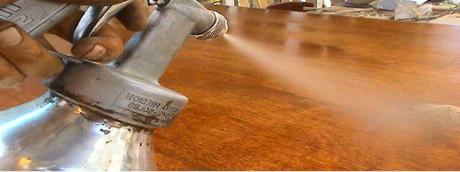Wood Treatment and Protection – Decor Poducts
For the treatment and protection of wood, different products are used in different sequential steps. First we must take into account if the wood is going to be exposed to the interior or exterior and if the environment also contains some elements considered aggressive.
Wood protectors are divided into two types
- Decorative products for surface protection: they protect the wood against atmospheric agents such as sun, rain, snow, UV rays and humidity changes.
- Technical wood protectors: These elements are composed of chemical elements that protect the wood from bio-agents such as fungi, bacteria, and even termites or other insects.

Decorative products for surface protection
Varnish:
Coating material that, when applied to a material, ends up forming a transparent solid film (totally or partially) with insulating, protective and decorative properties. It is used both indoors and outdoors. It can be applied by brush, synthetic roller or spray machine

Paint:
Coating material with specific pigments normally in liquid form, which when applied on a surface, forms a film with specific insulating, protective and decorative properties. It can also be applied outdoors or indoors. Same form of application as in the case of varnishes.

Wood Stain:
These are products that leave the pore open to the wood. In addition, biocidal elements can be added, solar filters that allow the retardation of wood oxidation. If the Wood Stains are pigmented the oxidation effect is further delayed. They can be used indoors and especially outdoors. In the case of application, the brush is convenient because of its greater capacity to penetrate the product into the Wood. On the application of the Wood Stain or impregnating we will refer later

Raw Materials Used in the Treatment and Protection of Wood
The most used in the manufacture of wood surface protection products are the following:
Resins (binder): its function is to waterproof wood against the action of water or other liquid elements.
Pigments: its function, in addition to its decorative mission, is to reduce the effect of the sun, UV and infrared rays.
Solvents: its function is to transport and dissolve the resin and pigments without altering their chemical composition. Water (water-soluble) or Organic Solvents (organic or synthetic solvent products) are usually used.
Various components: its function is to improve its effectiveness in terms of protection. and added to solvents. The most common are hydrophobic, fungicides, insecticides, diluents, sunscreens, antioxidants or inhibitors
Types of application in surface treatments
Brushstroke:
The application of the protector on the wood is done by several product hands, by brush, brush (also the roller applies). The necessary time must be left to dry as specified by the manufacturer of each product. The wood must be dry free of internal exudation and the surface clean, especially of dust. The protection resulting from this application is very good indoors and very low outdoors, especially if it is exposed to the sun or other atmospheric agents such as rain.

Powdered in the treatment and protection of wood:
An applicator or electric spray gun is used. This method saves time since its application is faster. in turn, the varnish paint layer is thinner than the previous method and takes less time to dry. Also consult the manufacturer of the products about this method of application. The protection of this application system is similar to the previous one. Also as the previous method the wood must be dry and clean. There is professional spraying in the tunnel, but it is not the subject of this topic, so we will not develop it here.

Immersion:
This application system consists of totally submerging the wood in ambient temperature conditions, for a period of time. Then the wood is removed and dried, especially in airy and dark environments. This method is not recommended in an environment with humidity higher than 70%.

Description and use of application types
Treatment and Protection of Wood by Brushing
The protector that is applied (varnish, paint or Lasur) is organic or solvent based. The product is applied by brush, brush or roller. The mentioned product penetrates the pores of the wood by capillarity. This method consists of a superficial protection against the action of organic or environmental agents.

Considerations to take into account
Humidity:
Wood used indoors must be dry or contain a low percentage of humidity (up to 12%). If it is to be used outdoors it may contain some more moisture and especially if Lasur is applied. (up to 20%). Check where the wood is bought this aspect.
Appearance:
The color and the grain of the wood are intrinsic decorative values that must be taken into account when applying the coatings.
Shrinkage:
the wood contracts and expands with heat and humidity. It is important to buy wood with a low coefficient of expansion, since these micro movements crack the protective layer. And especially if wood is used outdoors. Wood used indoors suffer very few variations. Check when the purchase is made for this issue and ask if the wood has already been treated with resins to reduce shrinkage.
Porosity:
Woods that are very porous absorb more product than less porous and therefore the application of wood sealants would be necessary.
Exudates:
Wood extracts are highly complex organic substances. They can be resins, oils, waxes or dyes (such as tannin). They can be viscous or liquid. If the wood has these characteristics, it is advisable not to apply any product, as they will prevent drying or crack protection. It would be un dried or not parked wood (green wood).
Preparation of the wood surface :
With dry, clean wood and without exudates, when the product can be applied. You should never apply the product with exposure to the sun, since it varies dramatically not only the drying times but the mechanics of the formation of the protective film

Spray Wood Protection
The protector is applied on the surface of the wood with a manual or electric spraying machine. When the system is used by spraying, it is more efficient than brushing, since the product is absorbed faster by penetrating the wood more.
Therefore it is advisable if it is going to be used outdoors, since this application system confers some more protection. Apart from all of the above, the application is done much faster and drying is too. The rest of the characteristics are similar to those of the brushstroke in terms of surface and condition is environmental

Immersion Wood Protection
Here the woods are completely immersed in a water soluble or organic solvent product for a period of time. This period varies between 30 seconds and 15 minutes, depending on the type of protector and the size of the surface to be treated.
The protective product is introduced into the wood through the pores inwards. This type of application has the advantage over previous systems, which achieves greater contact between the surfaces of the wood to be protected and the protective product. You can also regulate the amount of product to be absorbed through greater or lesser exposure.
The disadvantage is obvious, and it is a waste of product if it is not used for a large number of pieces to be protected. Drying should be aired, dry and never exposed to sunlight or high relative humidity.
Causes of degradation of the protective layers of wood
Here we will contemplate the causes by which the protection of the wood loses its aesthetic or structural condition and mutates its original conditions to another of decomposition or degradation.Atmospheric Agents: Sun, rain, Humidity, temperature and UV rays
If the wood is not treated, the water deposited on the surface of the wood is absorbed inside, allowing the proliferation of fungi and bacteria, apart from changing its structure itself. Thus deformations such as swelling, curvatures, and warping (in the form of a helix) occur. When dried in the sun, after absorbing water, cracks and cracks can occur.
Now, as the surface of the wood in question has been treated, we will see how the different agents of deterioration act against the protections applied to the wood. First we will cite all the degrading agents and then the recommendations for each type of protection and for each use.
Ultraviolet radiation
The wood protection layer is affected not only by ultraviolet rays, but also by infrared. Abrupt changes in surface temperature, end by difference between external and internal stresses by producing cracks. UV rays attack the surface being fibrous and cracked. In this situation the humidity can penetrate more deeply accelerating the deterioration of the wood.
The wood attacked by UV rays has a gray surface. This situation is resolved with brushing and bleaching salts. If the sun exposure process combined with rain (which washes the cellulose) does not stop, deterioration is irreversible. The layers of protection in the wood usually change their physical composition and degrade, appearing scales or fissures.
Infrared radiation
It produces the heating of the exhibition area, favoring the evaporation of moisture from the wood and in a superficial way. in this way there are tensions or forces that act between the wet interior and the dry surface, producing internal micro cracks. This is called thermal stress of the material. These cracks then allow the entry of destructive agents. This radiation also affects the protective layers applied, cracking them. Heating of the wood can also lead to resin exudate, depending on the species and damage the protective layer.

Atmospheric or environmental humidity
Wood is a material that absorbs moisture under normal conditions. A protective layer of varnish, paint or lasur, insulates it from this atmospheric agent. If the wood is in internal environments, humidity does not present a major problem. With three hands of protective coating is enough. But on the outside, if the wood has been exposed to sun and rain, the micro-cracks appear through which not only water but also ambient humidity will be absorbed. This is also valid where wood for humid environments with steam such as bathrooms and kitchens. The appearance of micro-fissures in the protective layer allows water to pass inside the wood, a fundamental factor to take into account in the treatment and protection of wood.
Freeze and defrost effect
The moisture contained inside the wood in regions where there are freezing temperatures, freezes. When this happens the ice increases its volume producing cracks inside the wood. In defrosting the wood does not return to its previous state, producing a deformation. and also cracks externally in the protective layers.
Fire or high Temperatures
Destroying element par excellence, exposure to fire, or high temperatures destroys the protective layer even in short periods. This can happen if the wood is near a heat source such as kitchens, grills or by accidental exposure.

Outside a Wood Stain is the most recommended.
Unlike varnish and synthetic paints, it penetrates deeply into the wood and does NOT form a layer. The finish is open pore, which facilitates the exit of natural moisture from the interior of the wood. They are ideal for outdoor wood that are exposed to environmental aggressions, as are all the elements listed above.

Its resins are highly flexible and adapt to the physical variations that the wood of the wood suffers. The lasures have bright, matt or satin finishes.
Outdoors, the use of synthetic varnishes or paints is not advisable because they do not withstand the aggression of environmental agents very well. Thus the aging of the film, cracks or directly the protective film is flaked.

The application of Wood Stain indoors
For the treatment and protection of the wood, if it is new it must be dry to ensure that it does not crack or deform. For the application of lasur the methods already described are used, but we recommend the brush and well-loaded, since the wood penetrates deeply. If inside the wood is not exposed to the sun you can use colorless lasur, with low UV protection.
It should be taken into account that the erosive action of the sand and salt particles carried by the wind in the coastal areas wear and erode the surfaces more quickly, so the maintenance periods should be shorter.
The application of Wood Stain :Outdoors
The same recommendation for brush application as the previous one taking the following precautions.
- For a good treatment and protection of the wood, sand the wood previously in the direction of the grain with fine grade sandpaper.
- Do not use other accessories to clean such as scourers, bleach, lavandines etc.
- If fungicides are applied, let dry at least 24 hours before applying the lasur.
- When wood funds are applied, do so after the fungicide application.
- Do not apply Lasur directly in sunlight. This dramatically modifies the natural absorption and drying times.
- If the wood is wet, let it dry for at least 24 to 48 hours, in a dry place and repaired from atmospheric elements
- Do not apply outdoors if the temperature is near the freezing point
- Apply in rain or in environments with 70% relative humidity is totally inadvisable
- Use brushes that do not lose the bristles. We recommend flat brushes and not brushes.Lasures
Wood Stain are to water or solvent. A layer of one can be applied to the water on the other solvent, as long as the layer on which it is to be applied is completely dry. For the treatment and protection of wood with lasures, it should be borne in mind that water or solvent are application vehicles and that these evaporate completely and leave no residue. The woos stain are ideal for application on wooden pallets outdoors.

Maintenance of wood protections
The durability over time of a lasur, varnish or paint are directly related to the exposure time to the degrading elements: Humidity, water, steam, UV rays, infrared, sudden temperature changes, Snow or freezing temperatures.
Elements that have a horizontal position, where it can be deposited without draining rainwater or other moisture, require more maintenance.
It is usually recommended once a year to sand clean the protective layer, apply a smooth sanding and at least one coat of product. In the case of varnishes and paints, when they accumulate several layers, it is already advisable to completely remove all the protective layers. Then the application on clean wood is suitable again as if it were new. In the case of lasur just apply one more product hand. To avoid darkening of the protective layer, a transparent lasur should be applied.
Lovedecorate.com 2019
The Post Wood Treatment and Protection are published first on Love Decorate.. The Author is Love decorate - Love Decorate -
